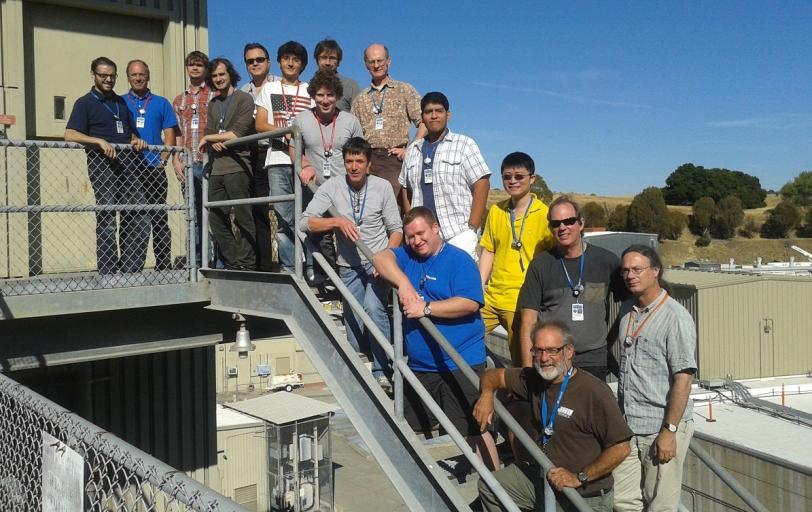Rebooted Muon Experiment Tests Detector Design at SLAC
Last year, a monster magnet set out from Brookhaven National Lab on an epic trek by land and sea to Fermilab, where it will serve as the heart of a search for evidence of new subatomic particles. Last month, researchers came to SLAC to test the eyes and nerves of the same experiment: a cutting-edge design for a new detector.
Last year, a monster magnet set out from Brookhaven National Lab on an epic, 35-day trek by land and sea to its new home at Fermilab, where it will serve as the heart of a search for evidence of new subatomic particles. Last month, with much less fanfare, researchers came to the End Station Test Beam (ESTB) facility at the Department of Energy's SLAC National Accelerator Laboratory to test the eyes and nerves of the same experiment: a cutting-edge design for a new detector.
The goal of the experiment, called Muon g-2 (pronounced gee-minus-two), is to precisely measure a property of muons by studying the way their spins precess, or wobble like a slowing top, in the grip of a powerful magnet. Researchers can track this spin by observing the muon’s decay into electrons, their lighter, longer-lived siblings.
In the experiment's original incarnation at Brookhaven, researchers discovered the spin rate is a tiny bit different from what theory says it should be – a difference that could indicate the influence of unknown virtual particles that pop into existence from the vacuum, affect the muons, and disappear once more.
However, the researchers at Brookhaven weren't able to measure the property precisely enough to know for sure. That prompted the relocation of the experiment – including the headline-grabbing move of the giant ring magnet – to Fermilab, with its more powerful muon beam.
More Muons = More Data
To take advantage of more muons, and thus more data, a team led by University of Washington physicist David Hertzog developed a new detector design for the experiment, a novel combination of lead-fluoride crystals and silicon photomultiplier chips that they hope will capture more information about the escaping electrons.
Hertzog and his colleagues brought some of the crystals and silicon chips to SLAC's ESTB facility, where electrons from the linear accelerator could stand in for the results of muon decays – but controlled and easily tracked muon decays, unlike what the detectors will face during the actual experiment.
"These detectors will need to catch a tremendous number of muon decays, pinpointing their times and the energies of the electrons," Hertzog said. "The electrons at ESTB can be delivered one at a time and with known energies, so we can see how the crystals and silicon photomultipliers respond."
The tests at ESTB have been much more low-key than the magnet's 3200-mile trek, but Hertzog said his team can also look back at a successful venture.
"This experiment has been really enjoyable," Hertzog said. "We've got good data and our system seems to be working well."
For questions or comments, contact the SLAC Office of Communications at communications@slac.stanford.edu.
SLAC is a multi-program laboratory exploring frontier questions in photon science, astrophysics, particle physics and accelerator research. Located in Menlo Park, Calif., SLAC is operated by Stanford University for the U.S. Department of Energy's Office of Science.
SLAC National Accelerator Laboratory is supported by the Office of Science of the U.S. Department of Energy. The Office of Science is the single largest supporter of basic research in the physical sciences in the United States, and is working to address some of the most pressing challenges of our time. For more information, please visit science.energy.gov.






